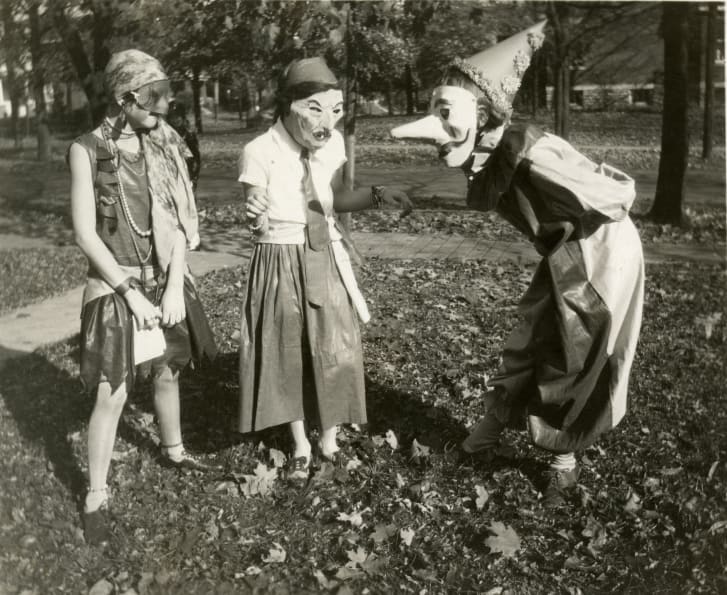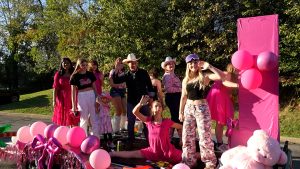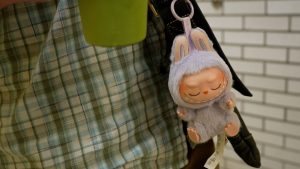9 Betwitching Facts About Halloween
Felix Koch/Cincinnati Museum Center/Getty Images
Our conception of Halloween has changed, often dramatically, over the past few centuries.
October 29, 2021
Halloween means different things to different people. For many children, it consists of free candy. For some, Halloween means haunted houses and getting scared with friends. And to others, it is just another day. No matter what your opinion is, a fascinating history behind this holiday exists, as well as many interesting ways it is celebrated
![]()
Many Halloween traditions come from the Gaelic holiday of Samhain
The Gaelic people, who are Celtics from Northern England, Scotland and Ireland, celebrated a holiday called Samhain. The first detailed mention of it comes from records by Irish monks who attempted to spread Christianity to Ireland in the 9th century, so the exact origin date of the holiday is unknown. We do know that Samhain existed at least as far back as the Romans. It was celebrated during the night of October 31st and into the day of November 1st with great feasts and bonfires as well as spiritual rituals. It was believed that, during this celebration, the barrier between the world of the living and the dead was at its weakest point. Many of our traditions, such as jack-o-lanterns and possibly “trick or treating” come directly from this Samhain.
![]()
Another holiday that influenced the creation of modern Halloween is All Saints Day
The exact origin of All Saints Day is unknown. Some put the origin as far as back as the 4th century CE, although by the 8th century C.E. Christian churches in Ireland were promoting it. This is believed to have been a way for these Christian monks to integrate Celtic pagan festivals into a more Christian-oriented celebration without ruining the essence of the holiday. In many ways, Halloween has roots in the synthesis of Christian and Gaelic celebrations.
![]()
Halloween hasn’t always been as widely celebrated as it is today
Much like many American traditions Halloween was brought over and influenced by immigrants, primarily the Irish. Early on in America’s history Halloween was celebrated in New England. However, it wasn’t popularized until the mid-late 19th century when a large number of Irish immigrated to the United States because of the potato famine in their native land. They brought their customs and traditions such as Halloween, while other immigrant groups integrated their autumn traditions into Halloween as well.
![]()
The connection between candy and Halloween is a somewhat recent invention
Children going door to door in order to get some kind of treat has only been a tradition since the 1920s. Back then the ‘treat’ may have been anything from small cakes to toys, or even money. Not to mention that a precursor to trick-or-treating called “souling” was a sort of Halloween caroling believed to have been practiced by Gaelic people. Souling did not include candy, which only became the staple Halloween treat when it was popularized in the 1950s when the sugar rations of the Great Depression and World War II were lifted. Companies took a hold of this trend, and by the 1970s candy became a staple of Halloween. In the 21st century, about two-billion dollars’ worth of candy is given out on the holiday every year.
![]()
Haunted Houses originally were supposed to keep people out
Today, many people go to local frights to get scared, while some even travel across America to find the scariest Haunted House. These modern attractions were originally intended for the opposite. During the Great Depression, it was common for teens and children to commit vandalism out of restlessness. This was especially common during the Halloween season. In order to prevent this, families started decorating basements, garages, and yards in order to give the restless youth something to do that could also create an adrenaline rush without property damage.
![]()
What exactly is the day before Halloween called?
Many people around the Pittsburgh area call the night before Halloween “Devil’s Night.” However, across the country it has one of the most diverse array of names of any singular day. In Vermont, it’s called Cabbage Night. In New Jersey and eastern Pennsylvania, it is known as Mischief Night. In New Hampshire and the Dakotas, Gate Night. What does not vary is what exactly occurs on this night: mischief, pranks, and sometimes vandalism.
![]()
Roman Influence on Halloween
Much like many of our customs on Halloween, the ancient Romans influenced Halloween as well. After the conquest of many Gaelic tribes in Northern England, they combined the two Roman holidays with Samhain, as they all occurred around the same time. These Roman holidays celebrated the passing of the dead and the goddess of orchards and fruit, Pomona, with Samhain. This is where some Halloween activities, such as apple bobbing, are believed to have come from.
![]()
The Death of Harry Houdini
Although not directly related to the holiday itself, Houdini died in a very strange way on this most grim holiday in 1926. The official story is that a fan punched him during one of his acts where he often received punches to appear to be resistant. However as he was not prepared for the punch, this punch resulted in an appendix rupture, Resulting in him dying a week later on October 31st. Many suggest that there’s more to this story. Houdini was famous for touring America and attempting to debunk psychics and supposed haunts, which resulted in many of the people in this line of work to grow very sour of him. Some believe that it would not have been surprising if they did despise him to such an extreme that they poisoned him.
![]()
“Witch” is a gender-neutral term
Out of the many “creatures of the night” we dress up as, tell stories of, and put up decorations of on Halloween, witches have the largest misconception about them. One of the most common associations of witches is that they are very elderly or very young women, though the term itself is gender-neutral. Common terms that are often used for a male witch, warlock and wizard, have separate meanings. A warlock is a witch who goes against a coven, a grouping of witches, while a wizard is just any practitioner of magic. The word “witch” has two definitions, a practitioner of malignant magic or a practitioner of Wicca. The modern type of Wicca was interestingly started by a former British soldier and archeologist named Gardner. Neither definition of “witch” is exclusively gendered. Even historically, the term did not exclusively refer to women suspected of witchcraft. During the infamous Salem Witch Trials, six men were accused of being witches, although this was usually after they stood up in defense or protected one of the accused women.













